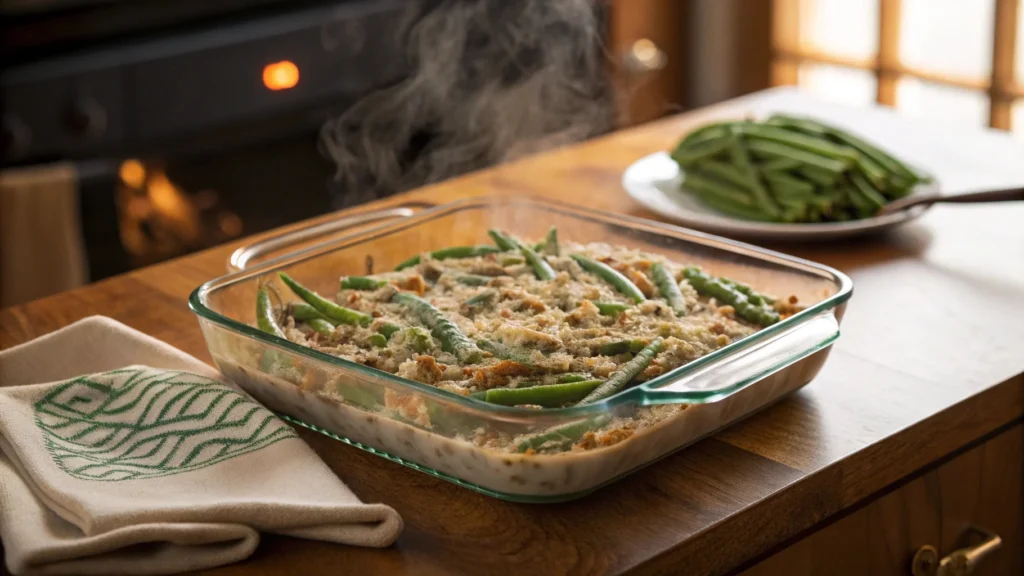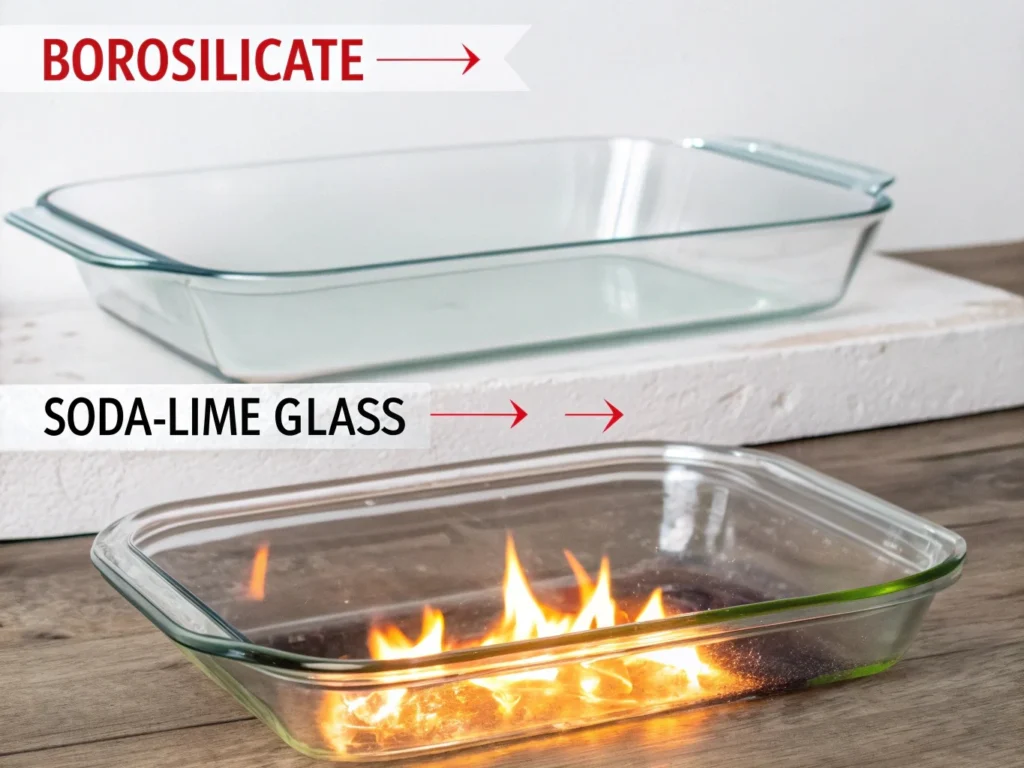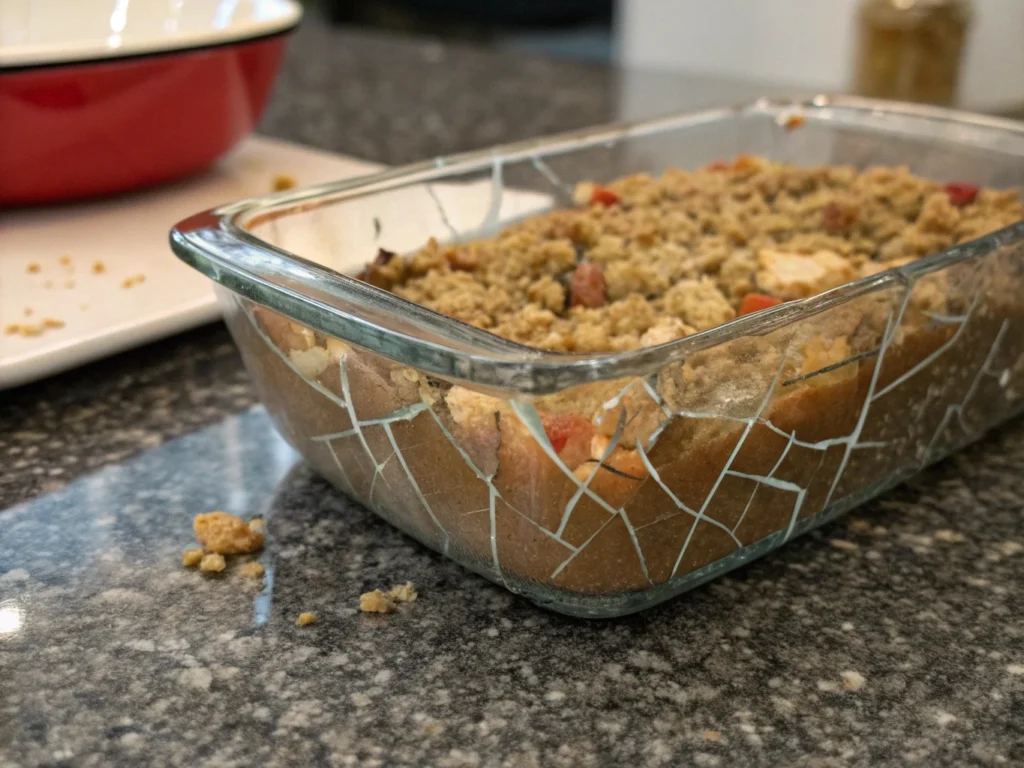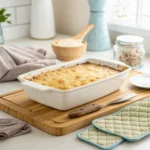Pyrex temperature limits set the line between a flawless casserole and shattered glass—do you know yours?
It’s Thanksgiving morning, and you’re making your famous green bean casserole. You grab your trusted Pyrex dish, ready to create a masterpiece. But do you know the Pyrex glassware temperature limits for safe use?
Knowing Pyrex’s heat tolerance is key to avoiding kitchen disasters. It’s about cooking with confidence and protecting your kitchen tools. Every home cook needs to know the temperature guidelines for Pyrex to perform perfectly every time.
My experience with Pyrex has shown that knowing the right temperature limits is vital. Whether you’re a seasoned chef or a weekend cooking enthusiast, mastering Pyrex’s temperature capabilities is essential.

Key Takeaways
- Pyrex can safely withstand oven temperatures up to 425°F
- Avoid sudden temperature changes to prevent thermal shock
- Always preheat your oven before placing Pyrex inside
- Use potholders when handling hot Pyrex dishes
- Check your Pyrex for any signs of damage before use
What Are Pyrex Temperature Limits and Why They Matter
Explore the amazing world of Pyrex, a glass technology that has changed cooking and science. Its secret is its special mix and its amazing heat resistance.
What Is Pyrex Made Of?
Pyrex glass is a mix of scientific ingredients. It has about 80% silica, 13% boric oxide, and 4% alumina. This mix makes a glass that stays stable in extreme temperatures.
Special Properties of Borosilicate Glass
Borosilicate glass is known for its heat resistance. The boric oxide in it helps it handle sudden temperature changes well. It’s loved by scientists and cooks for its ability to avoid cracking.
Differences Between Borosilicate and Soda-Lime Glass
Not all glass is the same. Soda-lime glass is common, but borosilicate glass is better. Soda-lime glass breaks easily under heat, but borosilicate glass stays strong.

| Glass Type | Thermal Resistance | Common Uses |
|---|---|---|
| Borosilicate Glass | Excellent | Laboratory equipment, cookware, telescope mirrors |
| Soda-Lime Glass | Limited | Drinking glasses, windows, basic kitchenware |
Learning about Pyrex shows why it’s trusted for cooking, science, and industry. Its heat resistance makes it a wonder of science.
Maximum Safe Pyrex Temperature Limits in the Oven
Understanding temperature limits for oven-safe Pyrex bakeware is key for safe cooking. Modern Pyrex glassware can handle specific heat levels that every home cook should know.
Pyrex bakeware can safely reach up to 425°F (218°C). This range meets most kitchen cooking and baking needs. The glass in today’s Pyrex is made from tempered soda-lime glass, not the original borosilicate.
Recommended Temperature Guidelines
To keep your Pyrex in top shape, follow these temperature tips:
| Cooking Method | Maximum Temperature | Recommended Precautions |
|---|---|---|
| Standard Oven Baking | 425°F | Preheat oven, avoid sudden temperature changes |
| Microwave | Microwave-safe rated | Check for microwave-safe label |
| Direct Heat Sources | Not Recommended | Avoid stovetops to prevent cracking |
Safely Increasing Temperature
Slowly increasing temperature prevents thermal shock. Start by letting cold dishes warm up to room temperature before oven use. Always preheat the oven for consistent heat and to avoid glass breakage.
Modern Pyrex is less heat-resistant than the original. Taking good care of your glassware will keep it in great shape for longer.
Curious about using Pyrex in specific recipes like crème brûlée? Here’s a guide on using Pyrex safely for crème brûlée.
Minimum Temperature Considerations
Pyrex glassware is amazing at handling extreme temperatures. It’s made of borosilicate glass, which makes it strong and safe for many uses. You can find it in kitchens and labs.
Pyrex is special because it can handle very cold temperatures well. Unlike regular glass, it doesn’t break down when it gets really cold. This is thanks to its special mix of materials.
The Incredible Cold Tolerance of Pyrex
Both scientists and home cooks love Pyrex for its cold tolerance. It can even handle temperatures as low as -190°C. This makes it perfect for working with things like liquid nitrogen.
In labs, Pyrex stays stable at around -70°C for a long time. This is really useful for many experiments.
Preventing Thermal Shock in Cold Environments
To keep your Pyrex safe from thermal shock, follow these tips:
- Avoid sudden changes in temperature
- Slowly adjust the glassware to new temperatures
- Check for cracks or damage before using it in extreme cold
| Temperature Range | Pyrex Performance |
|---|---|
| Room Temperature | Optimal Stability |
| -70°C | Sustained Laboratory Use |
| -190°C | Extreme Cold Tolerance |
Knowing about pyrex thermal shock resistance helps you use your glassware better. It’s good for many different temperatures.
How to Use Pyrex Glassware Safely
Understanding Pyrex dishes temperature ratings can be a challenge. But don’t worry, I’m here to help. I’ll show you how to use your glassware like a pro. Knowing the right techniques will make your Pyrex last longer and work better.
Best Practices for Pyrex Handling
Temperature control is key when using Pyrex. Always let your glassware reach room temperature before heating or cooling it too much. This step prevents sudden breaks or shatters.
Here are some important tips for handling Pyrex:
- Never put a hot Pyrex dish on a cold surface
- Use a trivet or dry towel when setting down hot glassware
- Slowly heat or cool your Pyrex to keep it strong
Tips for Using Pyrex in Ovens and Microwaves
Pyrex is great for cooking and reheating. To use it safely, follow these tips:
| Cooking Method | Temperature Limit | Recommended Practices |
|---|---|---|
| Oven | Up to 500°F (260°C) | Avoid preheated ovens, use moderate temperature changes |
| Microwave | Safe for microwave use | Ensure dish contains microwave-absorbing material |

By following these guidelines, you’ll keep your Pyrex safe and enjoy it for years. A little care can make a big difference in keeping your Pyrex collection in top shape!
What Happens If You Exceed Pyrex Temperature Limits?
Cooking with high-temperature Pyrex needs careful attention to avoid kitchen disasters. Knowing the risks of overheating can prevent unexpected breakage and injury.
When using high-temperature Pyrex, it’s key to follow temperature limits. The glass is heat-resistant, but it’s not perfect. Sudden temperature changes can cause it to shatter.
Common Breakage Causes from High Heat Exposure
Using Pyrex beyond its safe temperature can lead to problems. The glass might get tiny cracks, weaken, or break suddenly while cooking or cooling.
| Temperature Range | Risk Level | Potential Outcome |
|---|---|---|
| Below 150°C | Low | Safe for most cooking |
| 150-230°C | Medium | Increased risk of thermal stress |
| Above 230°C | High | Significant risk of shattering |

Ways to Avoid Breakage or Shattering
To prevent accidents with high-temperature Pyrex, handle it carefully. Always put glassware on a dry, room-temperature surface. Don’t move it from freezer to hot oven or vice versa. Gradual temperature changes are your glassware’s best friend.
Check your Pyrex for chips or cracks before each use. Small flaws can weaken the glass under heat. If unsure, replace it for safe cooking.
Pyrex’s Resistance to Thermal Shock
Knowing about pyrex glass thermal properties is key for safe cooking. Many kitchen items struggle with temperature changes. But Pyrex stands out with its remarkable thermal resistance.
The science behind Pyrex’s thermal stability is interesting. Originally made from borosilicate glass, these tools were designed to handle big temperature swings. Borosilicate glass can handle sudden temperature changes of up to 330 degrees Fahrenheit. This makes it very durable in the kitchen.
Understanding Thermal Shock Mechanisms
Thermal shock happens when a material faces quick temperature changes, causing stress. Pyrex glass has properties that greatly reduce the risk of breaking. From 2011 to May 2020, only a few glass cookware incidents were reported each month. This shows how safe these products are.
Features Enhancing Thermal Stability
Modern Pyrex has special designs to lower thermal shock risks. It’s recommended to let cold dishes sit at room temperature for 30 minutes before baking. Also, using a thin liquid layer while cooking helps control temperature changes.
To stay safe, avoid putting hot Pyrex on wet surfaces. Always check your dishes for cracks or chips before using them. These simple steps can help your glassware last longer.
Even though current Pyrex is made from soda-lime glass, it’s not as good as borosilicate. Yet, it can handle temperatures up to 425° Fahrenheit.
Differences in Temperature Limits Among Products
Pyrex glassware has different temperature limits for each type. Not all Pyrex is the same when it comes to heat. Knowing these differences helps you use your glassware safely in the kitchen.
Baking Dishes vs. Measuring Cups
Baking dishes and measuring cups have different heat limits. Baking dishes can handle up to 500°F (260°C), perfect for the oven. Measuring cups, on the other hand, can’t handle as high temperatures.
| Pyrex Product | Temperature Limit | Recommended Use |
|---|---|---|
| Baking Dishes | Up to 500°F | Oven cooking |
| Measuring Cups | Up to 350°F | Limited heating |
| Specialty Glassware | Varies | Check individual product specifications |
Specialty Pyrex Items and Their Limits
Specialty Pyrex items like storage containers and mixing bowls have their own temperature limits. Some modern Pyrex uses tempered glass, which is different from traditional borosilicate glass. Always check the manufacturer’s guidelines for specific pyrex glassware temperature limits before use.
Pro tip: Look for the “oven-safe” symbol or consult the product manual to ensure you’re using your Pyrex glassware within its recommended temperature range.
Caring for Pyrex to Maintain Heat Resistance
Keeping your Pyrex glassware in top shape needs careful care and specific cleaning methods. How you clean, handle, and store these kitchen tools greatly affects their heat tolerance.
Cleaning Tips to Maintain Integrity
Start by cleaning your Pyrex gently. Stay away from harsh scrubbers that could damage the glass. Soak dishes in warm, soapy water for 30 minutes to get rid of stuck-on food. Use soft sponges to clean without scratching the glass.
Pyrex’s heat tolerance improves by avoiding damage. Scratches and chips make the glass more likely to break from heat. Always use non-metallic tools and soft cleaners to keep your glassware safe.
How Storage Affects Pyrex Thermal Durability
Storing Pyrex right is key to making it last longer. Here are some important tips:
- Store dishes carefully to prevent chips and cracks
- Avoid stacking heavy items on top of Pyrex
- Keep lids separately to prevent unnecessary pressure
Managing temperature is vital for Pyrex’s heat tolerance. Always let dishes cool down to room temperature before putting them in extreme places like ovens or fridges.
| Storage Practice | Benefit |
|---|---|
| Vertical lid storage | Prevents warping and damage |
| Soft padding between stacked dishes | Reduces risk of scratches |
| Avoid sudden temperature changes | Prevents thermal shock |
Pro tip: Check your Pyrex often for wear, like small chips or scratches. Replace damaged items to ensure safe cooking and keep performance at its best.
When to Replace Pyrex Glassware
Keeping your Pyrex dishes in good shape is key for safe cooking and baking. Pyrex dishes temperature ratings can change over time. It’s important to know when to replace your glassware.
Spotting wear signs is vital for kitchen safety. Scratches, chips, or visible cracks mean your Pyrex might need to be replaced. These issues can weaken the glass, making it unsafe for temperature changes.
Signs of Wear and Possible Breakage
Watch for these signs that your Pyrex needs to be replaced:
- Deep scratches or etching on the surface
- Visible cracks or chips, even small ones
- Discoloration or cloudiness that doesn’t come off with cleaning
- Uneven surface that suggests structural damage
How to Safely Dispose of Damaged Items
When your Pyrex can’t be used anymore, dispose of it safely. Wrap broken glass in newspaper or bubble wrap. Then, put it in a sealed container. Check with local recycling centers about glass disposal in your area.
Remember, pyrex dishes temperature ratings can change over time. Older Pyrex was made with borosilicate glass, which was safer. Today’s Pyrex uses soda-lime glass, which is more prone to breakage from temperature changes.
If you’re not sure about your Pyrex’s condition, it’s safer to replace it. Replacing it can prevent accidents and keep you safe while cooking.
Comparisons with Other Glassware Brands
Exploring borosilicate glass heat resistance is key. It’s important to see how different brands compare. Pyrex is well-known, but how does it fare against others?
Pyrex vs. Competing Brands
Pyrex is known for its thermal properties. Many brands use borosilicate glass, but not all are as heat-resistant. TN LAB glassware, for example, uses Borosilicate 3.3 glass. This is considered top-tier in thermal stability.
| Brand | Thermal Resistance | Primary Use |
|---|---|---|
| Pyrex | Moderate to High | Cooking, Baking, Storage |
| Simax | Very High | Cooking, Laboratory |
| Corningware | High | Oven-to-Table |
Unique Features of Competing Brands
Different brands shine in different ways. Simax glass is incredibly durable, handling temperatures from -40°F to 572°F. Corningware, on the other hand, excels in thermal shock resistance thanks to its ceramic makeup.
Pyrex is versatile for cooking and storage. But, some brands focus on specific uses. Knowing each brand’s strengths and weaknesses is essential when looking at borosilicate glass heat resistance.
FAQ about Pyrex Temperature Limits
Using Pyrex in the oven can be tricky. I’m here to guide you through the safe use of Pyrex bakeware. Let’s explore common questions about this versatile glassware.
Top Questions About Pyrex Safety
Can I use my Pyrex in the oven? Yes, but with some important caveats. Pyrex is safe up to 425° Fahrenheit. It’s key to follow guidelines to avoid breakage.
What temperature limits should I know? Modern Pyrex has specific limits. Remember these: • Maximum oven temperature: 425°F • Avoid sudden temperature changes • Never use on direct heat sources
Critical Safety Tips
To avoid thermal shock, follow these tips: • Let cold dishes sit at room temperature for 30 minutes before baking • Never put cold Pyrex into a hot oven • Avoid adding cold liquids to a hot Pyrex dish
Where to Find More Information
Looking for more on safe Pyrex use? Check these reliable sources: • Manufacturer’s official website • Cooking safety websites • Professional cooking forums • Consumer product safety guides
Quick Safety Checklist
| Do | Don’t |
|---|---|
| Use in preheated oven | Use on stovetop |
| Allow gradual temperature changes | Place in broiler |
| Check for cracks before use | Microwave when nearly empty |
Your safety in the kitchen is most important. Always check your Pyrex’s instructions and be cautious.
Conclusion: Ensuring Safe and Effective Use of Pyrex
Knowing about Pyrex glass thermal properties is key for safe kitchen use. Pyrex glassware can handle temperatures from -104 to 572 degrees Fahrenheit. To get the most out of your Pyrex, follow its handling and structural limits.
Keeping Pyrex safe from thermal shock is vital. Make sure dishes are at room temperature before microwaving. Check for chips or cracks and avoid sudden temperature changes. Proper storage and gentle cleaning with soft materials will help your glassware last longer.
Always put safety first when using Pyrex. Choose products safe for the microwave, follow heating guidelines, and watch for wear signs. These steps will keep your kitchenware and you safe from misuse risks.
Pyrex is a reliable and versatile kitchen tool if used wisely. Follow these tips, and you’ll enjoy your Pyrex for many years.
🍽️ For more cooking safety tips and high-heat recipe ideas, check out this article on using Pyrex for crème brûlée. It’s a great example of how to handle delicate baking in glassware.
FAQ
1. What temperature can Pyrex glass withstand?
Modern Pyrex glassware, made from tempered soda-lime glass, can safely withstand temperatures up to 425°F (218°C). Always preheat your oven and avoid sudden temperature changes to prevent thermal shock.
2. Is Pyrex safe at 500 degrees?
While some older Pyrex baking dishes made from borosilicate glass may handle up to 500°F, modern Pyrex is not officially rated above 425°F. Exceeding this may lead to cracking or shattering.
3. Can you bake a glass dish at 450?
It depends on the type of glass. Pyrex is generally not recommended for baking at 450°F, as this exceeds its standard safety range. Always refer to the product’s official temperature rating.
4. Can glass go in a 450 degree oven?
Only specific glassware designed for high-heat use should go into a 450°F oven. Standard Pyrex should not, as it risks thermal stress or breaking. Use borosilicate-based or ceramic alternatives if higher temperatures are needed.
5. How do you prevent Pyrex from shattering during use?
To avoid breakage, allow Pyrex to come to room temperature before placing in a hot oven, avoid placing hot glass on cold surfaces, and inspect for chips or cracks before use.
6. How should I care for my Pyrex to maintain its heat resistance? Clean your Pyrex gently with non-abrasive cleaners. Avoid extreme temperature changes. Store it carefully to prevent chips or cracks. Regularly inspect for damage. Proper care will keep it heat-resistant and long-lasting.

Safe Pyrex Oven Use: Temperature Limits and Handling Tips
Description
Learn the temperature limits for safely using Pyrex glassware in your oven. This guide helps you avoid thermal shock and cook with confidence.
Ingredients
(No ingredients – this is an informational guide, not a recipe)
Instructions
1. Always preheat your oven before placing Pyrex inside.
2. Let cold Pyrex sit at room temperature before baking.
3. Do not exceed 425°F with modern Pyrex glassware.
4. Avoid sudden temperature changes (e.g., freezer to oven).
5. Inspect Pyrex for chips or cracks before each use.
6. Place hot Pyrex on dry, room-temperature surfaces only.
7. Do not use Pyrex on stovetops or under broilers.
Notes
Modern Pyrex is made from soda-lime glass and is less heat-resistant than vintage borosilicate versions.
Never bake above 425°F unless specifically stated by the manufacturer.
Use trivets or towels to prevent contact with cold countertops.
Always check product instructions for your specific Pyrex item.
